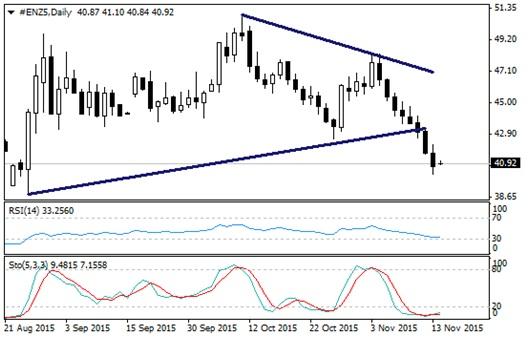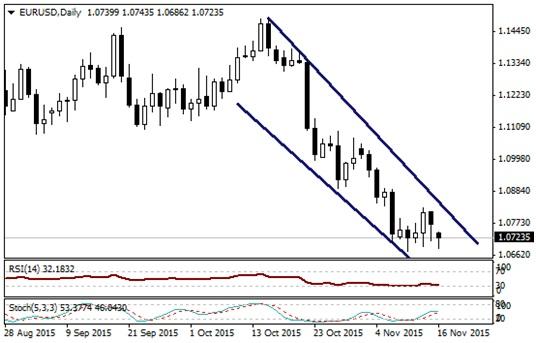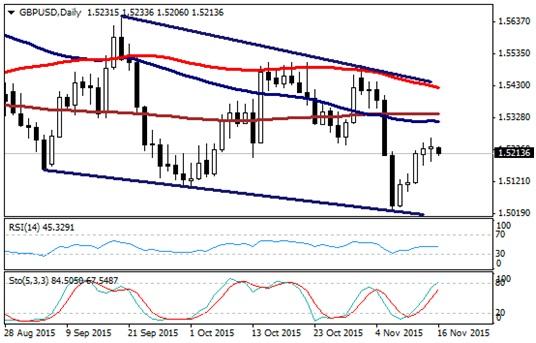Following the tragic events in France on Friday evening and after losses were noticed throughout the Asian markets overnight, expectations are high that the global markets are going to remain under pressure as trading for the week gets under way. The tragic events in France are likely to weigh on investor sentiment and will probably encourage some riskaversion from investors. Investor sentiment towards global markets was already looking shaky as last week concluded, and the recent events are going to weigh further on this.
Other reasons to expect a weak open to trading for the week includes the price of WTI Oil falling to a fresh two-month low at the conclusion of last week, alongside confirmation in the early hours of Monday morning that the Japanese economy has fallen into another recession. Due to the increased appetite for safe-havens from investors following the tragedy in Paris on Friday evening and the expectations that lower commodity prices will also pressure equity markets, the news of Japan entering another recession has not really been priced into the Yen.
Looking ahead to the economic calendar for week, the major release that investors will be anticipating arethe FOMC Minutes on Wednesday evening. Following the recent rebound in expectations that the Federal Reserve will carry out its repeated pledge to begin raising US interest rates in 2015 next month, traders will be looking for further clarity that policy members are keen to raise interest rates in December.
WTI Oil hits another two-month low
The combination of consistent and clear signs of there being an aggressive oversupply in the markets and slowing demand for the commodity due to global concerns have been pivotal behind the commodity falling to another two-month low at $40.21. Investor sentiment towards WTI looks weak and bearing in mind that attraction towards oil is limited at present, we look at risk to falling back below $40. This would add further pressure to the equity markets, and damage the potential for those commodity-linked currencies. I would also not be surprised to see pressure on the FTSE 100, which has a strong correlation to mining stocks and that can be impacted by lower commodity prices.
In regards to the technicals on the daily timeframe, WTI looks to have concluded its inverted wedge pattern. The commodity has also fallen below its lower trendline and with it moved back towards $40 as highlighted in this market report. Although both the RSI and Stochastic indicators are indicating that WTI is heavily oversold, traders might see the move towards $40 as encouragement to attack the commodity once again and force prices back to the $30’s.
EURUSD falls back towards six-month low
The resumption of an obvious contrast in both economic and monetary sentiment between the United States and Europe continues to encourage sellers to attack the Eurodollar. The EURUSD is currently positioned marginally close to its six-month low at 1.0673 and with GDP growth missing expectations late last week, it is difficult to see the EURUSD bouncing higher. Can the EURUSD bounce higher as the week commences? For this to occur, the FOMC Minutes release later this week would have to cause widespread weakness to the USD.
Overall, there is an overwhelming divergence in both monetary and economic sentiment that is going to encourage the Eurodollar to remain under pressure. The combination between expectations resuming that the Federal Reserve will raise US interest rates next month, alongside slowing GDP growth in Europe and the ongoing stagnant growth concerns with dangerously low inflation putting pressure on the European Central Bank (ECB) to unleash further stimulus is why some traders remain optimistic that parity in the pair this year is still possible.
GBPUSD attempting to recover losses
The GBPUSD has managed to recover some stability after a period of heavy selling, however the pair is currently finding its recovery capped below the 1.53 range as highlighted in this market report. The GBPUSD is at risk ofgiving up some of its recent recovery in momentum as the new trading week commences. While this could be encouraged by a period of risk aversion following the tragic events in France, there are also other reasons to expect demand for the Pound to slow down.
For example, Bank of England (BoE) Chief Economist Andy Haldane made downbeat comments over the UK economy late last week and this couldput investor attraction at risk. The reason for the possible impact on investor attraction is not limited to the downbeat comments used, but because Haldane’s clear stance againstUK interest rates being used too soon indicates how resistant the members of the BoE are towards raising interest rates.
The major event risk for the UK economy this week is the latest round of UK inflation data. The BoE have always expressedstrict views on UK inflation, and another weak inflation reading will continue to push back expectations for a UK interest rate rise.
From a technical standpoint on the daily timeframe, prices are still trading below its 50 and 200 MA’s and this will likely act as stubborn resistance for the GBPUSD if the pair does manage to move higher. The Stochastic has now rebounded away from the oversold area and is now looking overbought, which could validate why the GBPUSD is likely to move lower at the beginning of the week.
Emerging markets
The sentiment towards the emerging markets continues to remain weak and repeatedly under heavy pressure fromreoccurring factors such as US interest rate optimism, depressed commodity prices and elevated concerns over the China economy entering a deep economic downturn. With the stacks so heavily against the emerging markets and many of them being impacted by the threat of continually low commodity prices, it is difficult to be optimistic about a recovery in sentiment at present.
To be honest, the increased risk over WTI Oil returning back below $40 is dangerous news for any currency that is home to an economy with a reliance on commodity exports. This hurts the emerging markets more than most with this largely being because these markets are not as diversified as developed markets, and also because they possess a high reliance on commodity exports.
Following another steep fall in the price of WTI and the overall continuous pressure throughout the commodity markets, it is looking like the Malaysian Ringgit is going to slide to another milestone low against the US Dollar. The inability of the currency to stabilize and recover momentum, plus the expectance of a peak in inflation over the next couple of months is exactly why I remain cautious that the Bank Negara might look to raise interest rates at some point in the future.
The Indonesian Rupiah is also expected to give back some of its recovery in momentum following the rebound after the government introduced a series of economic packages to rebalance domestic sentiment. The Indonesian stock markets are also looking at risks ahead following the resumption in selling throughout the commodity markets. The chances are increasing that there will be one more milestone low when it comes to the oil markets before the end of the year, meaning the emerging markets will remain at risk to further losses.
Comparebroker is a comparison site and we spend hundreds of hours to keep the information up to date. However, users are advised to do their own due diligence and nothing can be perceived any advise. The content on the website is purely for education purposes only
Recommended Content
Editors’ Picks
EUR/USD clings to gains above 1.0750 after US data

EUR/USD manages to hold in positive territory above 1.0750 despite retreating from the fresh multi-week high it set above 1.0800 earlier in the day. The US Dollar struggles to find demand following the weaker-than-expected NFP data.
GBP/USD declines below 1.2550 following NFP-inspired upsurge

GBP/USD struggles to preserve its bullish momentum and trades below 1.2550 in the American session. Earlier in the day, the disappointing April jobs report from the US triggered a USD selloff and allowed the pair to reach multi-week highs above 1.2600.
Gold struggles to hold above $2,300 despite falling US yields

Gold stays on the back foot below $2,300 in the American session on Friday. The benchmark 10-year US Treasury bond yield stays in negative territory below 4.6% after weak US data but the improving risk mood doesn't allow XAU/USD to gain traction.
Bitcoin Weekly Forecast: Should you buy BTC here? Premium

Bitcoin (BTC) price shows signs of a potential reversal but lacks confirmation, which has divided the investor community into two – those who are buying the dips and those who are expecting a further correction.
Week ahead – BoE and RBA decisions headline a calm week

Bank of England meets on Thursday, unlikely to signal rate cuts. Reserve Bank of Australia could maintain a higher-for-longer stance. Elsewhere, Bank of Japan releases summary of opinions.


